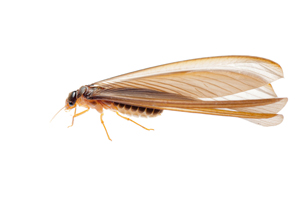 Termites are voracious.
Termites are voracious.
They’ll stop at nothing to eat you out of house and home and in many cases, by the time they’re detected they’ve already caused thousands of dollars in damage. Getting rid of termites is no simple matter but the sooner you get started the less damage you’re likely to incur.
Signs You May Have Termites
Once you’ve noticed signs of termites you can bet they’ve already made themselves at home. Though subterranean termites are the most common species in the U.S., drywood and dampwood termites are prevalent in regional areas. Here are a few signs you may be heading for a termite issue…
Swarms: Most types of termites live in large colonies that swarm together when the weather is warm. Look for large swarms at dusk as termites search out a new home.
Holes and Tubes: Subterranean termites travel through earthen tubes to tunnel into the lowest level of your home, so look for eraser-sized holes in mud or soil. If you see circular holes directly in your home’s wood, call a professional immediately.
Shavings: As termites eat their way through wood they leave wood shavings and scraps behind. If you notice wood in the dirt near your foundation or even inside your basement you’ve probably got termites.
How to Get Rid of Termites
In a vast majority of termite infestation cases it’s best to call an exterminator right away. Pest professionals are specially trained to spot and identify termites and quickly, efficiently remove them from your home and just a few months of inaction or improper corrective action can cost you thousands in damages and allow the problem to get worse.
If you’d like to try to eradicate your termites before bringing in professional help, try one of the following:
Set a bait station (purchased from a hardware store) for termites to find. They’ll bring the poison back to the nest and share it with the colony.
- Coat affected wood surfaces with boric acid, a natural insect repellent. If there’s a finite amount of wood to eat your termites may head for richer ground once they become hungry.
- Flood your soil if you suspect you’ve got subterranean termites. They’re unable to swim and will quickly drown if you’re able to effectively fill your yard with water.
- Buy some nematodes at an outdoor center. These small, worm-like creatures feed on termites and may be able to naturally control their population, particularly if you’re not in the throes of a full-blown infestation.
It is possible to buy commercial-grade pesticides and insecticides in both foam and gas form but it is highly inadvisable that you use these compounds without the proper training. They are incredibly strong, difficult to place in the correct spot for termite control, and above all else, they’re dangerous to your family and pets if not applied properly.
If you have termites the best thing you can do is call a pest professional immediately. Exterminators know exactly which techniques will work for your property and what treatment options are available. They may need to employ a combination of treatments – bait, spray, liquid – to control your termites completely. There’s also a possibility a pest professional will be able to identify the queen of the colony; removing her from the nest is the #1 way to control an infestation.
Termites are nothing to take lightly. They cause billions of dollars in damage to properties around the U.S. each year, from Washington to Florida and everywhere in between. Call a professional exterminator today if you’ve noticed signs of termites in your home.


